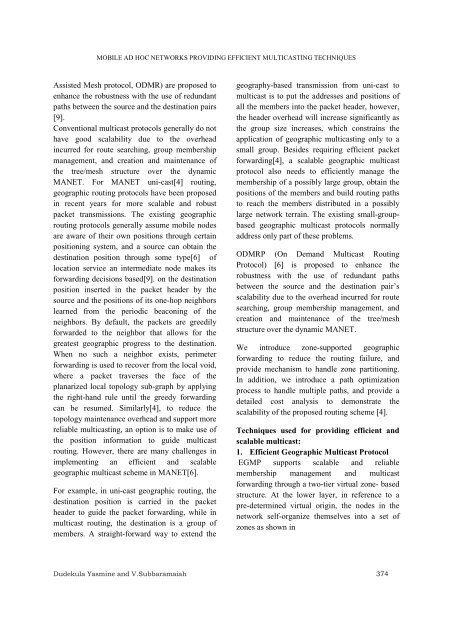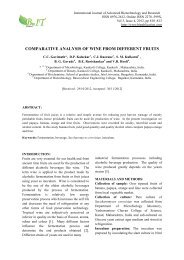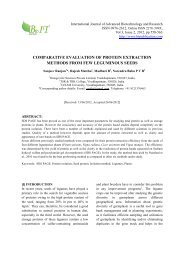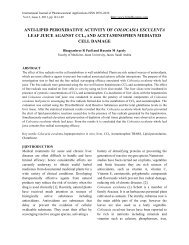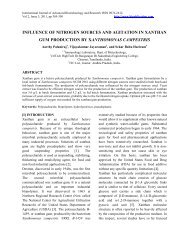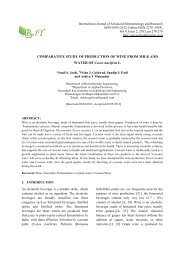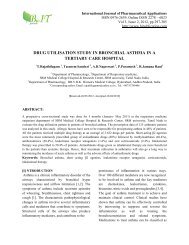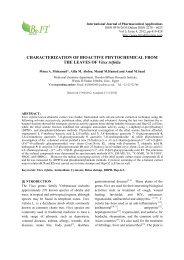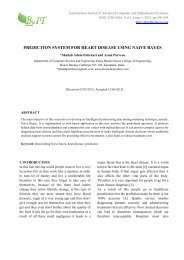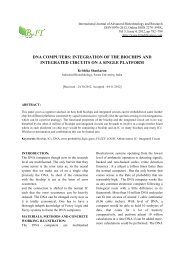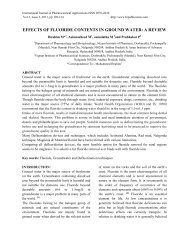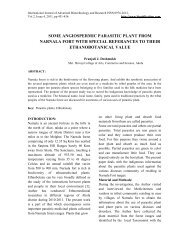mobile ad hoc networks providing efficient multicasting techniques
mobile ad hoc networks providing efficient multicasting techniques
mobile ad hoc networks providing efficient multicasting techniques
Create successful ePaper yourself
Turn your PDF publications into a flip-book with our unique Google optimized e-Paper software.
MOBILE AD HOC NETWORKS PROVIDING EFFICIENT MULTICASTING TECHNIQUESAssisted Mesh protocol, ODMR) are proposed toenhance the robustness with the use of redundantpaths between the source and the destination pairs[9].Conventional multicast protocols generally do nothave good scalability due to the overhe<strong>ad</strong>incurred for route searching, group membershipmanagement, and creation and maintenance ofthe tree/mesh structure over the dynamicMANET. For MANET uni-cast[4] routing,geographic routing protocols have been proposedin recent years for more scalable and robustpacket transmissions. The existing geographicrouting protocols generally assume <strong>mobile</strong> nodesare aware of their own positions through certainpositioning system, and a source can obtain thedestination position through some type[6] oflocation service an intermediate node makes itsforwarding decisions based[9]. on the destinationposition inserted in the packet he<strong>ad</strong>er by thesource and the positions of its one-hop neighborslearned from the periodic beaconing of theneighbors. By default, the packets are greedilyforwarded to the neighbor that allows for thegreatest geographic progress to the destination.When no such a neighbor exists, perimeterforwarding is used to recover from the local void,where a packet traverses the face of theplanarized local topology sub-graph by applyingthe right-hand rule until the greedy forwardingcan be resumed. Similarly[4], to reduce thetopology maintenance overhe<strong>ad</strong> and support morereliable <strong>multicasting</strong>, an option is to make use ofthe position information to guide multicastrouting. However, there are many challenges inimplementing an <strong>efficient</strong> and scalablegeographic multicast scheme in MANET[6].For example, in uni-cast geographic routing, thedestination position is carried in the packethe<strong>ad</strong>er to guide the packet forwarding, while inmulticast routing, the destination is a group ofmembers. A straight-forward way to extend thegeography-based transmission from uni-cast tomulticast is to put the <strong>ad</strong>dresses and positions ofall the members into the packet he<strong>ad</strong>er, however,the he<strong>ad</strong>er overhe<strong>ad</strong> will increase significantly asthe group size increases, which constrains theapplication of geographic <strong>multicasting</strong> only to asmall group. Besides requiring <strong>efficient</strong> packetforwarding[4], a scalable geographic multicastprotocol also needs to <strong>efficient</strong>ly manage themembership of a possibly large group, obtain thepositions of the members and build routing pathsto reach the members distributed in a possiblylarge network terrain. The existing small-groupbasedgeographic multicast protocols normally<strong>ad</strong>dress only part of these problems.ODMRP (On Demand Multicast RoutingProtocol) [6] is proposed to enhance therobustness with the use of redundant pathsbetween the source and the destination pair’sscalability due to the overhe<strong>ad</strong> incurred for routesearching, group membership management, andcreation and maintenance of the tree/meshstructure over the dynamic MANET.We introduce zone-supported geographicforwarding to reduce the routing failure, andprovide mechanism to handle zone partitioning.In <strong>ad</strong>dition, we introduce a path optimizationprocess to handle multiple paths, and provide <strong>ad</strong>etailed cost analysis to demonstrate thescalability of the proposed routing scheme [4].Techniques used for <strong>providing</strong> <strong>efficient</strong> andscalable multicast:1. Efficient Geographic Multicast ProtocolEGMP supports scalable and reliablemembership management and multicastforwarding through a two-tier virtual zone- basedstructure. At the lower layer, in reference to apre-determined virtual origin, the nodes in thenetwork self-organize themselves into a set ofzones as shown inDudekula Yasmine and V.Subbaramaiah 374


